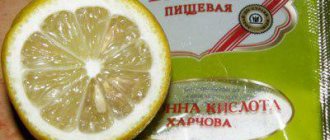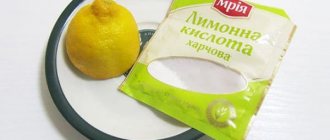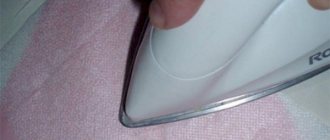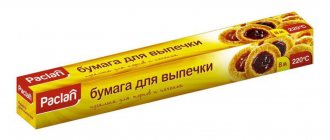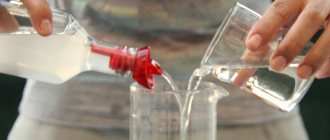In addition to using citric acid in everyday life and for preservation, we confectioners often use it in baking. Therefore, today I propose to pay attention to citric acid in confectionery, and what to do if it is not available.
Citric acid is crystals with a sour taste. The powder is obtained by biosynthesis from corn, cassava and sweet potato. For food purposes, citric acid undergoes more thorough purification with activated carbon.
Citric acid in moderation does not harm health, and, on the contrary, has a positive effect on the body.
Citric acid and lemon juice are different but interchangeable products. Most often, citric acid is used as an acidity regulator, preservative, and also as a flavoring additive.
Lime juice
Lime juice is the best substitute for lemon juice as it can be used as a one-to-one substitute and has a very similar taste and acidity level.
In fact, when canning food, it is an ideal substitute for lemon juice because it has a similar pH level. Other substitutes, such as vinegar, are less acidic and may cause the product to last for a shorter period of time.
In desserts where lemon juice is a key ingredient, lime juice adds a slightly different flavor. However, you will still end up with a tart and citrusy flavor.
How to use lemon zest for cooking?
For cooking, use both fresh lemon zest, dried and frozen. To get fresh zest, wash the citrus well under running water. Then scald with boiling water, blot with a napkin and grate the top yellow layer of lemon.
The aromatic seasoning can be prepared for future use. To do this, use a very sharp knife to remove the zest from the fruit in a spiral, being careful not to touch the white layer. Now the future seasoning needs to be dried. Lay it out on clean white paper on a windowsill or balcony and cover it with a cotton cloth or napkin. When the zest becomes brittle, the seasoning is ready. It can be ground into powder using a coffee grinder or blender, or crushed in a mortar. Dried zest should be stored in a glass container with a tightly closed lid in a dry place.
Citrus dishes. Watch the video.
When preparing main courses and sauces, zest is usually added to taste 3-5 minutes before readiness. Into dough, drinks and desserts - immediately. “Lemon powder” goes well with almost all spices, and in some cases can even replace salt. Often dried zest is mixed with various seasonings. For example, you should use lemon pepper for grilled fish and meat. Mix the zest with black pepper, salt, onion, garlic and turmeric. Rub the mixture onto the meat or fish 10-15 minutes before putting it on the grill.
For vitamin tea and cocktails, you can prepare lemon sugar. Grate the fresh zest and add sugar in a ratio of 1:2. Let it brew a little and add to your favorite drinks to taste. You can store it in a closed glass jar in the refrigerator for a long time.
The zest is also added to refined vegetable oil to give it a light lemon flavor. Cut the fresh peel into small pieces and pour in vegetable oil - olive or sunflower. Let it brew for 2 weeks, then strain and pour into a glass bottle. This oil is great for salad dressing.
It is worth noting that lemon zest is an excellent remedy for weight loss. Therefore, people watching their figure should more often consume dishes with lemon peel. For example, you can make vitamin bars.
Vitamin bar recipe
Pour boiling water over half a kilo of sweet dried fruits, such as dates, remove the seeds and, together with the fresh zest of one lemon, grind through a meat grinder or grind in a blender.
Mix with 3 tablespoons of honey and a little lemon juice.
Roll several sausages from the resulting mass and wrap them tightly in foil or cling film.
Leave in the refrigerator for a couple of hours, then cut the sausages into small pieces and roll them in chopped nuts or coconut.
With these bars you can satisfy your hunger throughout the day and not be afraid of extra pounds.
Lemon acid
Citric acid is a naturally occurring acid found in lemon juice, making powdered citric acid an excellent substitute for lemon juice, especially in baking.
One teaspoon (5 grams) of citric acid is equal in acidity to about 1/2 cup (120 ml) of lemon juice. This way, only a very small amount is required and you will need to make changes to the recipe.
To maintain the correct ratio of dry to wet ingredients, you may also need to add additional liquid to the recipe.
Plus, using citric acid in baking can even prevent certain vitamins and antioxidants from being destroyed during cooking.
Marinades and pickles
Citric acid is used in cooking to create preservative solutions. Here it is important to understand what function the marinade performs. If we are talking about canning for the winter, lemon can be replaced with table vinegar. It will definitely prevent fermentation from developing in jars and will preserve cucumbers, tomatoes, zucchini and herbs well.
When you need to pickle onions for salad, herring, mushrooms, fruit vinegar or 3-6% food vinegar along with sugar, salt and boiling water are also added to the marinade. For 1-2 onions, 1 tbsp is enough. concentrate and ½ tsp. bulk components.
If you marinate red tough meat, for example, beef, lamb, pork, it is best to use sweet and sour mixtures. These include wine vinegar, wine, cranberry or pomegranate juice. Tomato paste with spices diluted with water is also suitable. In extreme cases, use white vinegar, but it can give the meat a strong smell. For marinating fish and poultry, you can also give preference to white wine, citrus juice, apple wine or puree.
4-5 teaspoons of 3% vinegar replace ½ spoon of acid crystals. 1 small lemon will give about the same amount.
Potassium hydrogen tartrate (tartar)
Potassium hydrogen tartrate is an acidic powder sold in the baking section of most grocery stores.
Although it has many culinary uses, it is commonly used to stabilize the foam of egg whites or whipped cream. It is also included in baking powder.
Because it is sour, it can be used as a decent substitute for lemon juice in baking. Some websites suggest using 1/2 teaspoon potassium hydrogen tartarate for every 1 teaspoon lemon juice as directed in the recipe.
Keep in mind that you may need to add additional liquid to account for the lack of liquid in the cream of tartar.
Recommendations for taking the tincture
The most important thing in treatment with folk remedies is the correct dosage. Exceeding the optimal dose destroys the therapeutic effect of the drug and leads to harmful consequences
Vessel cleaning scheme:
- 1 day – 1 drop 3 times a day;
- Day 2 – 4 drops for 1 dose, 5 drops for 2, 6 drops for 3;
- Day 3 – 7 drops on 1, 8 – on 2, 9 – on 3;
- On days 4 and 5, continue in the same way, increasing the dose by 1 drop per dose, reaching 15 by the end of day 5.
After 3 days you need to take a break for 1 week and observe how you feel. For diabetes mellitus, honey can be used in consultation with your doctor. After a break, you can repeat the course if there are positive changes.
Summarize
- There are several ways to substitute lemon juice in cooking and baking.
- However, lime juice is the most ideal substitute as it is very similar to lemon juice.
- Keep in mind that when using a powdered or highly concentrated lemon juice substitute such as citric acid or lemon extract, you may need to add additional liquid to maintain the correct wet-to-dry ratio.
- The above lemon juice substitutes will ensure that you can continue cooking despite the lack of lemon juice.
Use in cooking
Lemon juice appears in recipes for a variety of baked goods, confectionery glazes, soups, marinades for meat and fish, and homemade mayonnaise.
Its sour nature (due to its citric acid content) not only gives dishes a fresh taste, but also:
- neutralizes fats contained in other ingredients;
- softens meat when using juice as a marinade;
- neutralizes parasites and pathogens in raw fish;
- in baking recipes it interacts with baking soda, working as a leavening agent;
- promotes browning of some baked goods;
- provides structure in jellies and jams;
- acts as a preservative in winter preparations, sauces and salad dressings;
- adds excellent taste and citrus aroma to confectionery glaze, neutralizing excessive sweetness in baked goods.
Your Answer:
If you want to add a comment to a question or check with its author for details, do not
use this form and click “Clarify/discuss the question” under the question text!
Single profile MediaFort
Register
What does registration give?
By registering on Povarenka, you can:
- add your own recipes;
- participate in ongoing competitions with many valuable prizes;
- save your favorite recipes to your “Cookbook”;
- ask cooking questions to recipe authors (and get answers!);
- communicate with other cooks on the forum.
It is important to know
You definitely need to remember that the shelf life of vinegar essence or simple natural vinegar is different. While the acid will not lose its properties for more than ten years, the natural product should only be used for a few years. After this period, the beneficial properties disappear, even if the vinegar looks quite suitable for use. It is not recommended to use the essence in mustard preservation recipes. Such a mixture can spoil the workpiece even before it is sent for storage. Instead, it is better to choose a different recipe or use simple table vinegar. Acetic acid is a residue from the production of fertilizers from natural gas or sawdust. Before using the product in preparations, you need to think several times whether preservation with such an ingredient will be useful. Even if the contents of a glass container are stored for several years, you should not risk your health when serving your favorite pickled vegetables. If you cannot do without preparing acetic acid, you need to store it out of the reach of small children.
Such a concentrated product can cause a painful, extensive burn in a child if it comes into contact with the skin, and if ingested, it can be fatal. Working with acid requires special attention and caution. If it gets on the skin, immediately rinse the injured area with cold water. If the damage is serious, consult a doctor immediately.
General principles for making lemon sauce
To prepare sauces, lemon zest and juice are usually used; pulp is rarely added. Seeds should always be removed from the fruit. The juice is usually squeezed by hand, since according to the recipe, 1-2 citrus fruits are enough.
If it is important that nothing unnecessary gets into the sauce, strain the squeezed mass through a strainer
Peel the lemon zest in a thin layer, without the white part, using a sharp knife or fine grater. First, the citrus needs to be washed well with a brush and the peel is doused with boiling water. In order for the lemon to release its juice well, it should be kept in hot water for several minutes, then rolled well on the table, after which you can cut it in half and squeeze it out.
The color of lemon sauce is easy to change. To color the dressing, use carrot or beet juice, turmeric, chopped fresh herbs, and soy sauce. The resulting product should be stored in a tightly sealed glass container for no more than 3 days in the refrigerator.
Lemon zest composition:
Lemon zest contains:
- Water – 81.6%;
- Dietary fiber – 10.6%;
- Carbohydrates – 5.4%;
- Proteins – 1.5%;
- Ash – 0.6%;
- Fat – 0.3%.
The chemical composition of lemon zest includes macroelements such as potassium, calcium, magnesium, sodium, and phosphorus. Among the microelements, lemon peel contains iron, copper, selenium, and zinc.
Lemon zest is rich in vitamins such as A, C, B1, B2, B4, B5, B6, B9, E, PP, alpha Carotene, beta Carotene, beta Cryptoxanthin, Lutein, Zeaxanthin. Most of all, lemon zest contains vitamin C. 70 grams of lemon zest contains the daily requirement of ascorbic acid. Dishes containing lemon zest are useful for strengthening the immune system and preventing colds.
The calorie content of lemon zest is only 47 kcal per 100 grams of product.
How to replace white or red wine vinegar
Acetic acid is a component that is part of any vinegar product, therefore, white and red wine are interchangeable products, and even a great gourmet cannot distinguish them from each other in a salad. If it is important for the cook to introduce an ingredient of a specific color into the composition of the dish (although they do not differ much in taste and properties), then he can replace it with ordinary grape juice, the amount of which should be 3 times larger.
Sometimes these components are replaced with grape juice diluted with white wine in a 1:1 ratio. Also, balsamic, apple, sherry, rice or any other vinegar of natural origin can act as a substitute.
Apple vinegar
Already from the name itself you can tell that it is made from apples. This product is very healthy and is used for preparing various dishes or even in cosmetology.
Despite all its advantages, apple cider vinegar is not recommended for canning.
If a canning recipe requires the addition of apple cider vinegar, it is better to prepare a small amount of salad or marinades so that they can be consumed in a short time. The short shelf life is compensated by its amazing taste; canned tomatoes or peppers acquire a new vinegary-fruit aroma, which in the blink of an eye will spread throughout the apartment.
Note to the hostess
Table for obtaining solutions of various concentrations
| Parts ratio (essence:water) | Solution concentration |
| 1:22,5 | 3% |
| 1:17 | 4% |
| 1:13 | 5% |
| 1:11 | 6% |
| 1:9 | 7% |
| 1:8 | 8% |
| 1:7 | 9% |
| 1:6 | 10% |
| 1:1,5 | 30% |
Vinegar added to water will prolong the life of a festive bouquet of flowers, drive cockroaches out of the house and stop hiccups, give dishes a unique taste and make hair smooth and shiny... This is a real miracle that came from time immemorial, but has not lost its relevance in the modern world!
Vinegar is something that every housewife has in her kitchen, who cannot do without it when preparing most culinary masterpieces. However, it also happens that it is not available at home, but 70% vinegar essence is available. This is a concentrated liquid where the acid to water ratio is 7:3.
More often in stores you can find a 70% solution, but you can also see 80% and 30% acetic acid. All these liquids are unsafe and should never be taken in their pure form. If it enters the body, the mucous membranes receive severe burns. So, in the absence of ready-made table vinegar, there is a concentrate that needs to be diluted, but few know to the required percentage.
It is worth noting that the product is very practical in everyday life. From 1 tsp. you can get a whole glass of the usual vinegar!
Choosing quality vinegar essence
Basic Rules:
- The liquid is bottled in glass bottles, transparent in color, without sediment.
- Label composition. The natural solution includes only water and 99% acid.
- Shake the bottle - the acid will begin to foam, then quickly settle. If the foam remains at the top, this is a sure sign of unnaturalness.
Why should you pay attention to this? When diluting the fake, you will get vinegar that is not the right percentage
Safety precautions when diluting
Incorrect or careless use of vinegar essence can negatively affect the body - cause poisoning or burns of mucous membranes and organs. To avoid getting into trouble, you should follow the rules:
When purchasing a solution, pay attention to the label with information about it and the concentration. Under no circumstances should you try the product in its pure form. Do not inhale acetic acid vapors; it may damage the mucous membranes of the respiratory tract. If you feel slight irritation in your nose and larynx, you should gargle with cool water or inhale with baking soda. In case of contact with eyes, rinse them immediately with water. In case of contact with skin, wash skin with soap and water. In case of poisoning, call an ambulance and rinse the stomach. Do not induce a gag reflex under any circumstances! Store the bottle of essence where children cannot reach it.
Dilution of vinegar essence to 9% and 6%
Let's imagine that you need 9% vinegar when preparing a dish, but you only have a concentrate that needs to be diluted. There is no need for magical abilities in this matter; you just need knowledge on this topic, which will be provided right away.
- The first thing you need is a glass container, for example, a glass or bowl
- Next, cold water is poured into the bowl, then the essence, exactly in this sequence
- Now the main thing is that with acetic acid at 70%, you need to take 7 servings of water (7 tablespoons) and 1 serving of concentrate (1 tablespoon)
- Result – 9% table vinegar
This technique can be done to get 6% vinegar:
You will need 10.5 tablespoons of water and 1 tablespoon of vinegar essence
Well, now it’s clear how to dilute vinegar essence
. Since some people may end up with 80% and 30% solutions, we will provide a calculation table below so as not to write down and, moreover, it is easy to remember.
A short educational excursion into history
Vinegar has been known to man since ancient times. It was obtained by fermenting wine, the favorite drink of the god Dionysus. This probably happened by accident, perhaps when one of the husbands forgot his vessel with a drink in the scorching sun.
The very first vinegar was made about 7,000 years ago from date wine in Ancient Egypt and Babylon. Used as an antiseptic and solvent in medical solutions.
These are some interesting facts, did you know about them?
So, having considered how to
dilute vinegar essence
at home, you don’t have to worry now that if you don’t have table vinegar on hand, you’ll have to run to the store to buy it.
Aromatic essences
Essences –
concentrated solutions of aromatic substances that are extracted from raw materials using solvents. Alcohol or vodka are usually used as solvents. The most commonly used essences for flavoring drinks are citrus, flower and rum essences. To prepare essences from herbs and roots, they must be well dried and crushed. They are mixed according to special recipes chosen or invented for each type of essence. A mixture of crushed herbs and roots is poured with an alcohol solution with a strength of at least 40 (°) and left for at least 8 days; This infusion is then distilled into essences for making drinks. The infused solutions are distilled in a special distillation cube, which has a cylindrical metal mesh (a metal glass with holes) in the middle, in which there are crushed roots and herbs. During distillation, the aromatic mixture is exposed to alcohol and water vapor, which extracts the essential oils contained in the infusion and, passing through the refrigerator, turns into a concentrated alcohol solution containing all the necessary aromatic substances. Essences are made with a strength of 65 (°), they can be stored for a long time without losing their aromatic properties. Essences are added in small quantities to alcohol solutions when preparing vodkas and original alcoholic drinks.
Aromatic essences are the secret to making strong spirits.
For the preparation of essences, the following are mainly used: orange, lemon, orange and cinchona peels, cloves, cinnamon, nutmeg and blossom, juniper, wormwood, galangal, calamus root, bay leaf, pine needles, vanilla, saffron, cardamom, coriander , eucalyptus leaves, celery, dill, yarrow, St. John's wort, bison grass, acorns, mint, sweet clover and many other medicinal and aromatic herbs.
English bitter.
Make a mixture of crushed raw materials: 8 g orange peel, 10 g cinnamon, 5 g galangal root, 1.2 g cubeba and orris root (iris), 4 g lemon peel, 1.8 g each nutmeg and ginger, 2.8 g cloves and 2.5 g cardamom. Place the mixture in a 1 liter container and add 250 ml of alcohol 50(°) concentration. Insist for at least a month. Distill. The result is 150 ml of light essence with a strength of 65 (°). Let stand for 3-5 days. To prepare strong drinks, use 0.5-3 ml of essence per 1 liter of alcohol solution.
Russian bitter.
Grind and mix: 2 g galangal root, 2.8 g angelica root, 2 g ginger root, 1 g cloves, 1.3 g English black pepper, 0.4 g Turkish capsicum root. The mixture is poured with alcohol 340 ml 50(°). Leave for at least a week. To prepare drinks, take 0.6-2 ml of essence per 1 liter of drink. For light varieties of vodka, the essence is distilled.
Pepper.
Lightly crushed and mixed ingredients: 3.2 g black pepper, 1.6 g Turkish pepper, 0.8 g galangal root, 0.1 g cloves - pour 150 ml of alcohol with a strength of 40 (°). They insist for two weeks. To prepare drinks, take 1.5-3 ml of pepper essence per 1 liter of drink.
